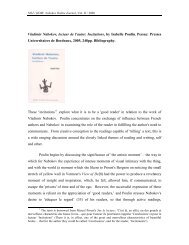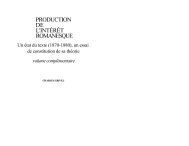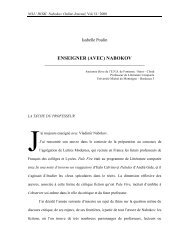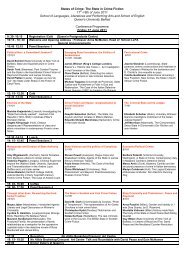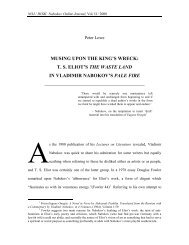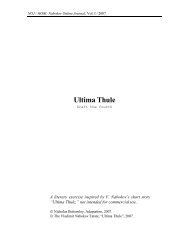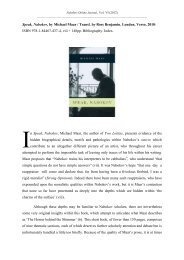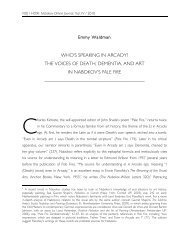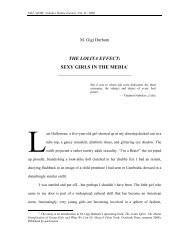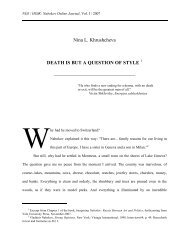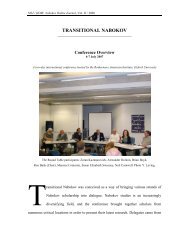domesticated translation: the case of nabokov's translation of alice's
domesticated translation: the case of nabokov's translation of alice's
domesticated translation: the case of nabokov's translation of alice's
You also want an ePaper? Increase the reach of your titles
YUMPU automatically turns print PDFs into web optimized ePapers that Google loves.
NOJ / НОЖ: Nabokov Online Journal, Vol. II / 2008<br />
Scholars in modern <strong>translation</strong> <strong>the</strong>ory such as Tymoczko (1999: 55-56), deny <strong>the</strong><br />
existence <strong>of</strong> a single polarity that describes <strong>the</strong> orientation <strong>of</strong> a <strong>translation</strong> and criticize<br />
this dichotomy. Tymoczko points out that a <strong>translation</strong> “may be radically oriented to <strong>the</strong><br />
source text in some respects, but [could] depart radically from <strong>the</strong> source text in o<strong>the</strong>r<br />
respects so as to assimilate it to a norm <strong>of</strong> a receiving culture” (Tymoczko 1995: 21).<br />
The truth has not been established yet. Domesticated <strong>translation</strong> is more natural<br />
and easy to understand because it is read as an original text. Foreignized <strong>translation</strong><br />
presents a foreign language and culture and for that reason requires a certain level <strong>of</strong><br />
knowledge about <strong>the</strong> source cultural environment. Both methods are mutually hostile,<br />
and <strong>the</strong> dualism still exists in <strong>the</strong> <strong>the</strong>ory and practice <strong>of</strong> <strong>translation</strong> while different reasons<br />
and evidence are provided to prove <strong>the</strong> primacy <strong>of</strong> each method.<br />
In <strong>the</strong> history <strong>of</strong> modern <strong>translation</strong> <strong>the</strong>re are scarcely any examples <strong>of</strong><br />
“betraying” one method and moving to <strong>the</strong> opposite approach. One <strong>of</strong> <strong>the</strong> rarest<br />
exceptions is Vladimir Nabokov, who used both methods in establishing his <strong>translation</strong><br />
doctrine. Only a few translators in <strong>the</strong> twentieth century possessed Nabokov's linguistic<br />
sensibility, and his contribution to <strong>the</strong> <strong>the</strong>ory <strong>of</strong> <strong>translation</strong> and practice is invaluable. In<br />
his <strong>translation</strong> <strong>of</strong> Lewis Carroll’s novel Alice’s Adventures in Wonderland, young<br />
Nabokov-Sirin used a <strong>domesticated</strong> method <strong>of</strong> radically familiarizing <strong>of</strong> <strong>the</strong> original. In<br />
contrast, his later <strong>translation</strong> <strong>of</strong> Pushkin’s novel in verse, Eugene Onegin, signified a<br />
complete transition to an extreme foreignized <strong>translation</strong>, aimed at keeping <strong>the</strong> original<br />
text as au<strong>the</strong>ntic as possible.<br />
This article focuses on <strong>the</strong> <strong>translation</strong> <strong>of</strong> Alice’s Adventures in Wonderland,<br />
exploring problems in <strong>translation</strong> arising from <strong>the</strong> differences between two languages and



